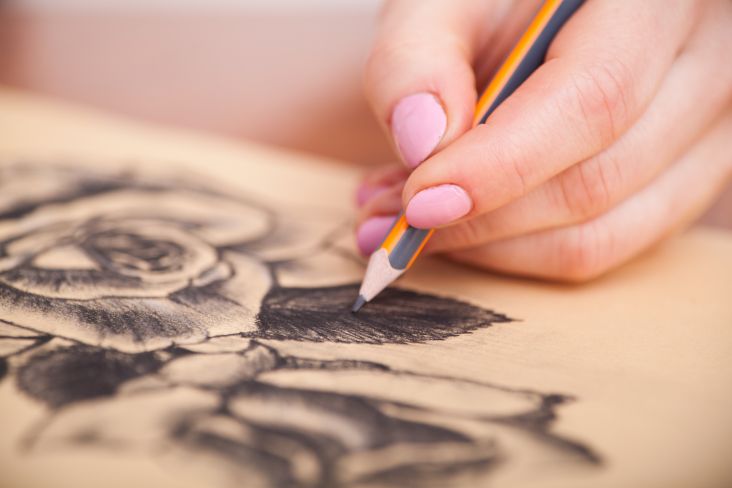Six mistakes designers make and how to avoid repeating them in 2019
New year, new start. Everywhere you look, people are joining a gym, loading up on healthy snacks, signing up for evening classes.

Image licensed via Adobe Stock
And that’s all to the good if you think those things will change your life. But the route to becoming happier, healthier and at balance with the world may be a lot simpler.
It may be that you don’t need a new body, or to master a new language, to feel comfortable in your own skin. After all, for better or worse, we spend most of our waking lives at work; so isn’t it better to start there?
At Shillington, where hundreds of students pass through our intensive design courses every year, we often see designers making the same common mistakes we're all guilty of. Here, we’ve identified six of the worst. And we also suggest some straightforward ways to avoid them, to make your working life more easy-going, efficient and fun.
1. Worrying too much about what others think
We’re all human, and it’s natural to be sensitive to what other people will think of our work. But at the same time, as a designer, it’s your job to see beyond conventional thinking, take risks and create something new and original.
So becoming overly concerned with the viewpoints of others can be very damaging to your creativity and ability to come up with innovative solutions to design problems. It’s why many designers just blindly copy trends or do everything their clients and bosses ask them to do unthinkingly, without ever pushing back – all the time thinking they’re “people pleasers”. They’re anything but.
But if you find yourself being paralysed by criticism or even fear of criticism, what can you do? Part of the solution lies in setting yourself clear and identifiable goals. Design is about solving problems, so if you can demonstrate how your design solves a particular issue, then comments like “I don’t like that shade of green” are less likely to be made, and will seem less relevant if they are.
It’s also about the way you ask for feedback. Ask specific questions such as "Do you think the typographic hierarchy is working, in drawing the eye to the most pertinent messages?" and you will tend to get more positive feedback that vague questions like "Do you like it?" or "What do you think?"
2. Spending too much time on your phone
From shopping to socialising, more and more of our lives are spent on our phones these days. But when convenience turns to obsession, and you find you’re spending more time on social media than working, it can become a real issue.
It’s easy to tell yourself you’ll cut down on your social media use. But remember, these apps are carefully engineered, by some of the world’s smartest people, to be as addictive as cigarettes or gambling. So if your willpower is fading, it may be time to take some tough action.
For a start, change your phone settings, so it no longer alerts you to likes, shares or messages on social media. They’ll still be there at the end of the day when you finish work, and you'll finish much quicker because you won't be so distracted.
Or, if you're with Apple, why not take advantage of iOS 12's new tools for monitoring and limiting your iPhone usage? Among its many new features are "App Limits", designed to help you reduce the amount of time you spend on things like Instagram.
If that doesn’t work, then install an app like Pyxsee which limits the amount of time you’re allowed to spend on social media per day. These tools are broadly aimed at children, but they work just as well for adults too!
Finally, there’s always the ultimate option of just removing the apps from your phone, or even leaving social media altogether. As humans, we’ve survived millions of years without Facebook, Twitter and Instagram, and you’ll survive too. You may be astonished by how much you achieve in life as a result!
3. Not believing in yourself
If you’re a designer with self-confidence issues, then you’re not alone. Many in this industry struggle with self-esteem, even while producing great work. And consequently, they see less talented designers who are nonetheless more willing to sell themselves to become more successful. Because after all, if you don’t believe in yourself, why should anyone else?
Building up your confidence is key to boosting your career as a designer, whether that means getting a promotion or being able to charge more to clients. So how do you do it?
It’s partly about being honest about your strengths and weaknesses. No one can be good at everything, but most designers have things they’re particularly good at, and not coincidentally these tend to be the things they enjoy and are most passionate about. So focus on those, carve out a niche or specialism, and you’ll soon be getting the kind of feedback you crave.
It’s also important to be realistic and stop comparing yourself with the very best. You may be no Stefan Sagmeister, but nor was Stefan Sagmeister at the start of his career; these things take time.
It’s wise to stop comparing yourself to others at all. Instead, start comparing your work now to your work one, two, three years ago. You’ll soon realise how far you’ve come and, by extension, how far you have to go.
4. Not getting paid
It seems bizarre that in 2019, we’re still talking about this. But getting paid, at all, can be a real issue for freelance designers.
Sometimes your payment can get lost in a morass of bureaucracy, mainly when the client is a large company. At other times, clients may be lax or stall payments as a matter of policy. Either way, it leaves you with rent to pay and an overdraft headache.
Unfortunately, there’s no way to be 100 per cent certain you will be paid on time. But you should at least make sure that you’re doing everything right yourself.
Primarily that means invoicing promptly: it might seem like a hassle, but it’s got to be done at some point, so the minute your work is delivered is as good a time as any.
If you need to invoice a lot, then an automated invoicing app such as FreeAgent can make things a lot easier and more efficient. Or there's Streamtime, which allows you to quote and invoice in a few clicks. (For further reading, check out our tips on invoicing.)
Your invoice will look more professional too. Morally, that shouldn’t make a difference in how long it takes for you to get paid; it’s just that in the real world, it does seem to, so why take the risk?
5. Working too hard
Working late, and sometimes through the night? Are you not sleeping enough? Rings under your eyes?
You may think you’re putting the maximum effort into forging your design career, and colleagues and bosses might be superficially impressed. But take it from us, although it might feel like it, that’s not the way to go.
If your work-life balance is so twisted out of shape that there’s very little ‘life’ to it, then you’re pushing yourself too hard, and both your creativity and productivity will inevitably suffer. Which means you need to do two things.
First, start planning in regular breaks during the day, and days off and holidays every month. That will leave you with less time overall to do your design work but, guess what? You’ll be so much more refreshed and alert that you’re sure to get everything done regardless, and the quality will almost certainly improve.
Secondly, spend some time thinking of ways at being more efficient in your work, so you can get more of the repetitive stuff done in less time. For starters, check out these 25 best tools for freelancers, (note: most of them are just as useful for employees).
6. Letting your portfolio get out of date
It doesn’t matter if you’re a junior, a mid-level designer or a creative director, you need to keep your portfolio updated, relevant and ready to go.
Why? Because you never know when you might get that call asking you to interview for that dream job or freelance contract. But if that call came today, would you be able to email over your portfolio without kicking yourself over the state it’s in?
On the one hand, adding the latest projects into your portfolio, and ditching some of the older ones, might seem like a tiresome task. But you usually find that once you get down to it, it’s kind of fun. And it’s pretty uplifting too.
“I made some smart decisions there,” you realise. “And it’s all turned out pretty well. I’m actually pretty good at this.” Like writing a diary in which you only include the good bits, updating your portfolio can be a great confidence booster in its own right.



















](https://www.creativeboom.com/upload/articles/66/66b7f1733a77a57db3e5e8d5a0e30474221d3127_732.jpeg)






